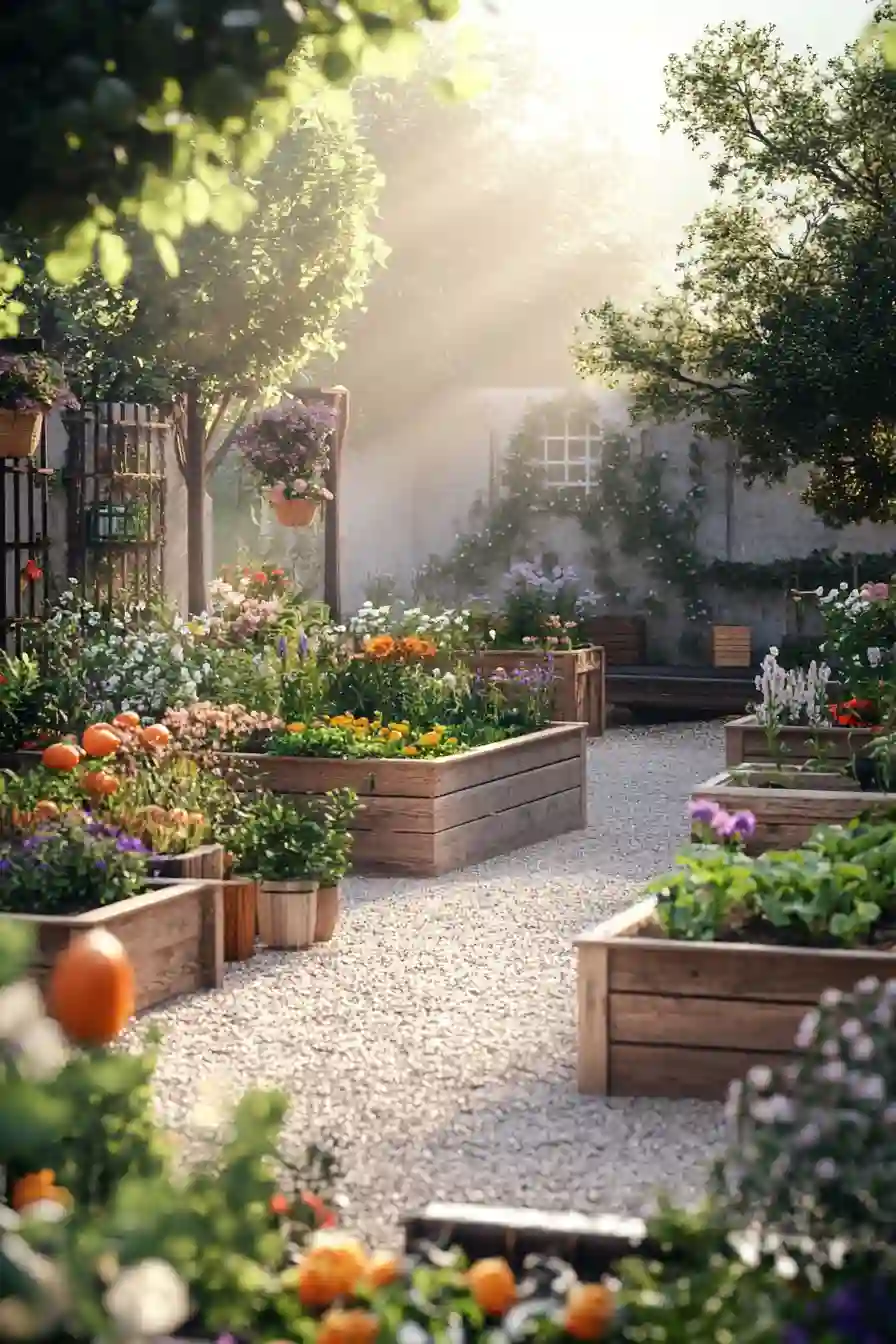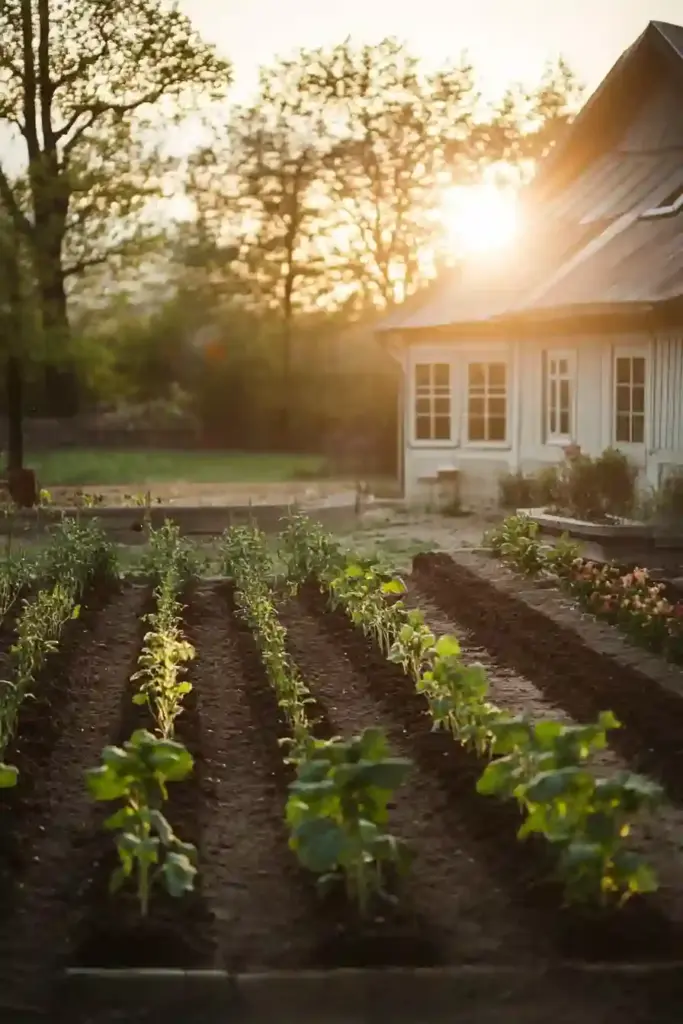There’s nothing quite like the joy of harvesting homegrown veggies from your own backyard. Whether you’re a green-thumbed veteran or just getting started, choosing the right vegetable garden design ideas can turn your outdoor space into a productive and beautiful sanctuary. From compact raised beds to whimsical mandala layouts, smart garden design blends function with style—making it easier (and more enjoyable!) to grow fresh, organic food right outside your door.
In this guide, we’ll explore a variety of garden design inspirations that cater to different spaces, styles, and skill levels. Whether you’re working with a balcony or a full backyard, you’ll find ideas here to spark your creativity and boost your harvest.
1. Simple Row Garden Layouts for Easy Maintenance
Sometimes, simplicity is the smartest design choice—especially for new gardeners. A classic row layout involves planting vegetables in parallel lines, either directly in the ground or in raised beds. This approach offers clean, organized structure and makes it easy to plan, plant, water, and harvest.
🌱 Why It Works:
- Efficient use of space: Perfect for rectangular yards or traditional garden plots.
- Ease of access: Clear rows create walking paths for quick harvesting and weeding.
- Crop rotation made simple: Swapping plant types from row to row each season helps maintain soil health.
✅ Pro Tips:
- Sunlight optimization: Plant shorter crops (like lettuce or radishes) on the southern side and taller ones (like tomatoes or corn) to the north to avoid shading.
- Irrigation-friendly: Linear layouts work well with drip irrigation or soaker hoses.
This layout is a great starting point for gardeners who value practicality and want a low-effort design that delivers big results.
2. Raised Beds with Trellises: Grow Up, Not Out
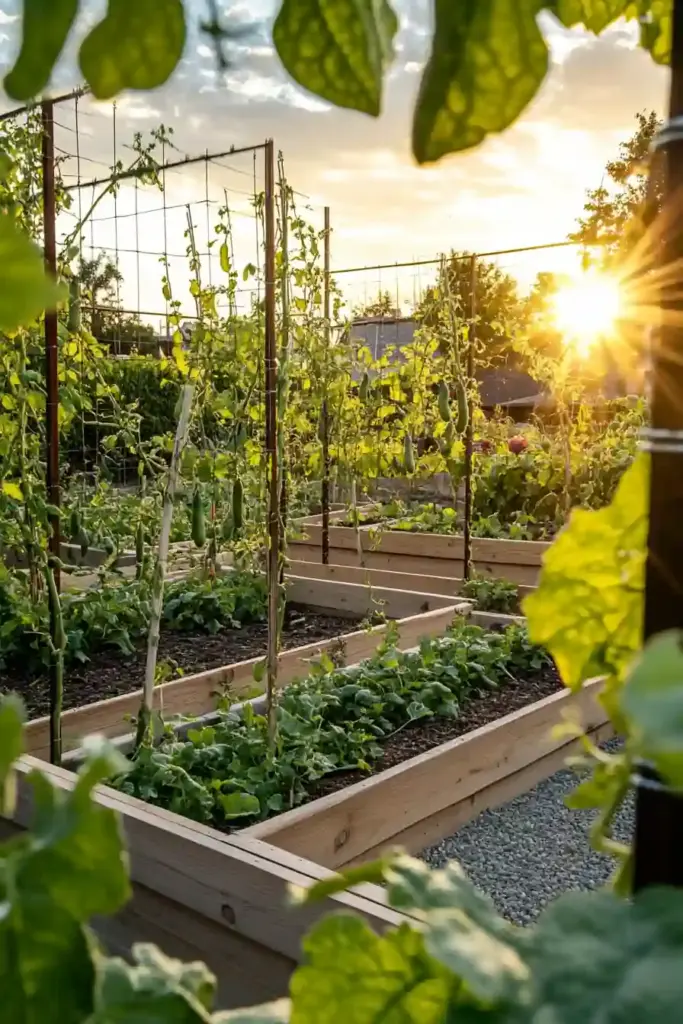
If you’re looking to maximize space and add vertical interest to your vegetable garden, raised beds with trellises are a fantastic option. This combination not only improves soil drainage and organization but also opens up room to grow climbing veggies like beans, peas, and cucumbers.
🌿 Benefits of Raised Beds with Trellises:
- Space-saving vertical growth: Ideal for small gardens, patios, or urban spaces.
- Healthier soil: You control the soil mix, leading to fewer weeds and better drainage.
- Improved yields: Vining crops thrive when trained upward, reducing disease and boosting air circulation.
🛠 Quick Tips:
- Use materials like cedar or recycled composite boards for durability.
- Install trellises at the north side of your raised beds to prevent shading.
- Train plants using garden twine, mesh panels, or decorative obelisks for support and style.
Raised beds with trellises give your garden a structured, elegant look while making the most of every inch. It’s functional, beautiful, and ideal for gardeners who want to grow more in less space.
3. Symmetrical Vegetable Garden Layouts: Timeless and Elegant
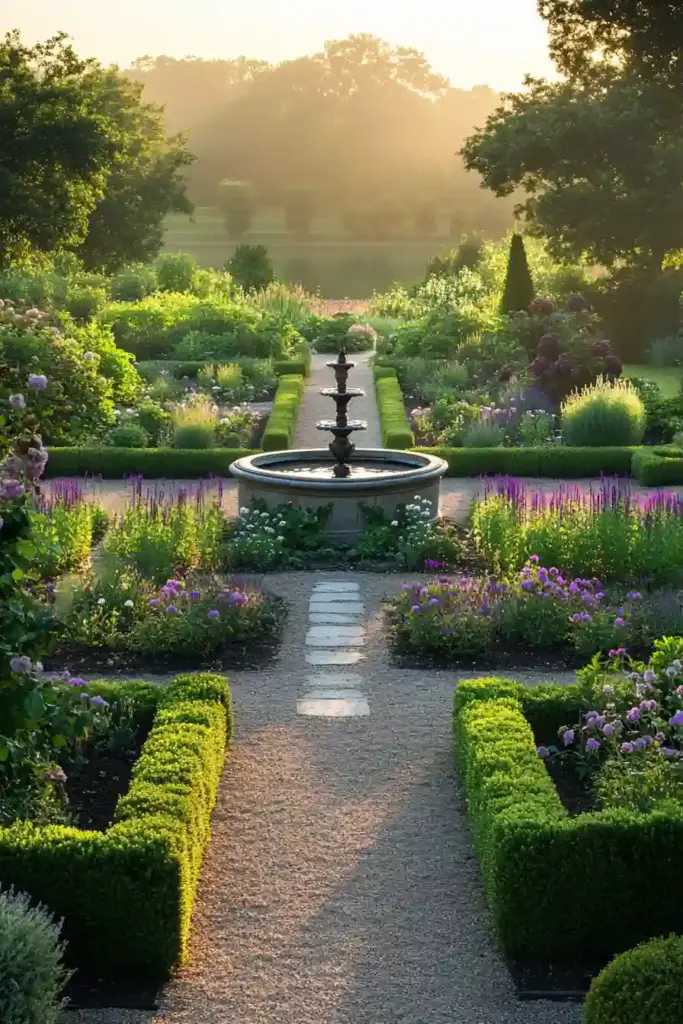
Symmetry brings a sense of order and calm to your garden. By mirroring your vegetable beds on either side of a central path, focal point, or decorative element, you create a layout that’s both practical and visually stunning. This classic design works especially well in formal gardens or as part of a front yard edible landscape.
🌸 Why Choose Symmetry?
- Visually appealing: Clean lines and mirrored elements create harmony.
- Efficient layout: Central paths allow easy access for planting, watering, and harvesting.
- Flexible focal points: Add a bench, birdbath, or vertical planter at the center for a touch of charm.
🌿 How to Create It:
- Divide your space evenly with straight paths.
- Use matching raised beds or containers on either side.
- Incorporate symmetry in plant choices too—for example, matching herbs or flower borders on both ends.
Symmetrical garden designs offer both function and flair, making your veggie patch look like a thoughtfully designed outdoor room.
4. Fence-Side Planting: Maximize Vertical Space and Style
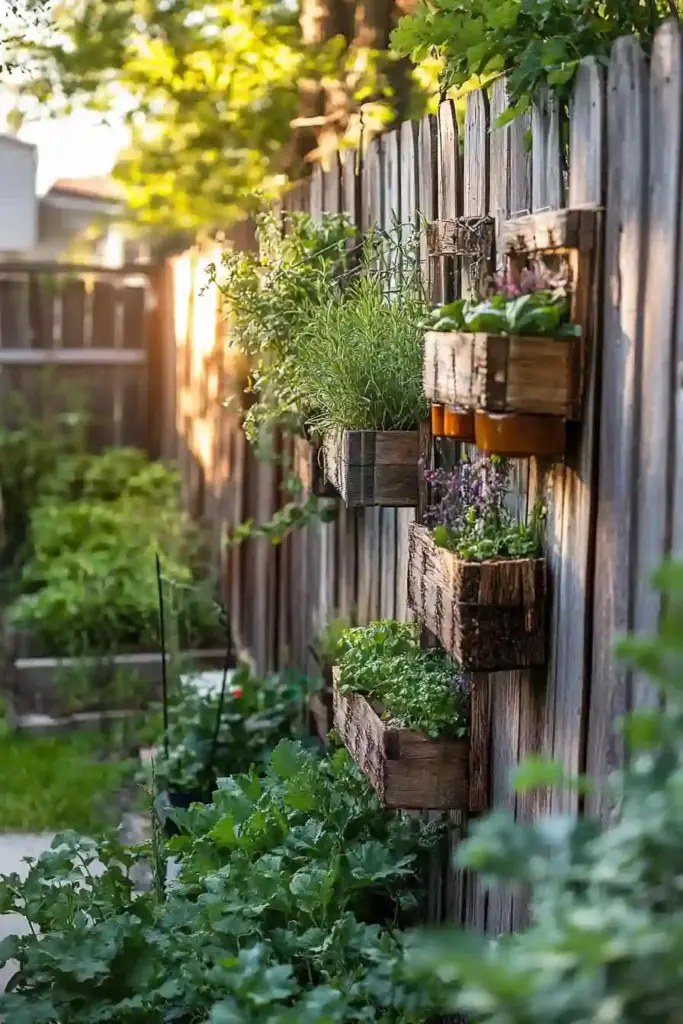
Got a fence or wall running along your yard? Don’t let that space go to waste! Fence-side planting is a brilliant way to turn vertical surfaces into productive garden zones. Whether you’re training vining veggies up a trellis or mounting planters directly to the fence, this design idea makes the most of tight or awkward spaces.
🌿 Advantages of Fence-Side Gardens:
- Efficient use of space: Perfect for small backyards or narrow side yards.
- Better airflow: Elevating plants improves circulation, helping reduce pests and disease.
- Great for companion planting: Grow herbs, leafy greens, or flowers alongside veggies for beauty and function.
💡 Design Ideas:
- Install horizontal slats or wire mesh panels for climbing crops like beans or cucumbers.
- Hang baskets or pocket planters filled with herbs, lettuce, or strawberries.
- Espalier fruit trees along the fence for a productive, space-saving orchard look.
This is one of the easiest ways to turn a plain fence into a lush, edible garden wall—practical and beautiful all in one.
5. Quadrant Garden Design: Organized Beauty with a Central Focal Point
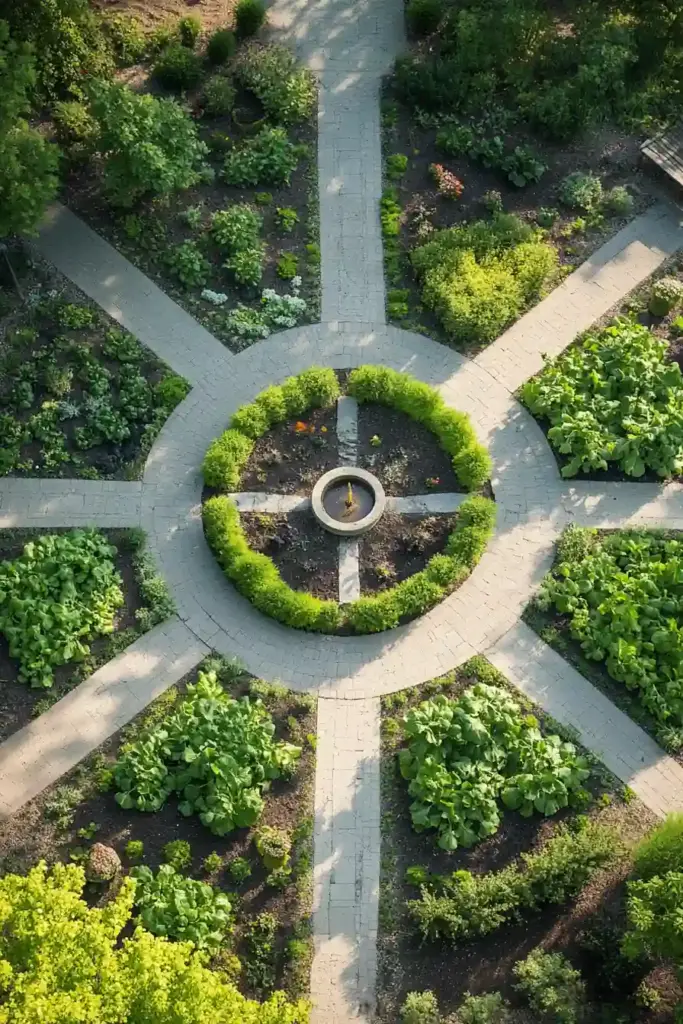
The quadrant layout is a timeless favorite for gardeners who love structure and symmetry. It divides the garden into four equal sections—perfect for rotating crops, organizing planting zones, or simply creating a striking, balanced look. At the heart of it all is a focal point, like a decorative urn, birdbath, or cozy seating area, that draws the eye and anchors the space.
🌿 Why Garden in Quadrants?
- Easy crop rotation: Switch plant families each season without confusion.
- Defined planting zones: Group veggies by type, growth habit, or watering needs.
- Stunning visual impact: The central feature gives your garden purpose and polish.
🌼 Tips to Try:
- Use stepping stones or gravel paths to divide the space into clear quadrants.
- Add a vertical feature—like a trellis or solar fountain—at the center for height and focus.
- Combine vegetables with herbs or edible flowers for texture, color, and pollinator appeal.
The quadrant garden is perfect for medium to large backyards and gives your edible landscape a sense of artistry and intention.
6. Symmetrical Edible Landscapes: Blending Form with Function

Who says vegetable gardens can’t be as beautiful as ornamental landscapes? With a symmetrical edible garden, you get the best of both worlds—lush, productive beds arranged in a visually balanced, decorative layout. These gardens are great for front yards, pathways, or anywhere you want curb appeal and homegrown goodness to coexist.
🌿 Key Benefits:
- Aesthetic value: Carefully placed veggies, herbs, and flowers mimic the look of a formal garden.
- Space versatility: Works well in both large and small plots.
- Functional zones: Group plants by height or purpose while maintaining symmetry.
🌸 Design Elements to Include:
- Use repeating shapes and mirrored planting beds.
- Frame paths with low-growing herbs like thyme or oregano.
- Mix textures—pair leafy greens with vibrant edible flowers or upright veggies like kale and chard.
This approach turns your vegetable garden into a true landscape feature—one that’s not only useful but also downright elegant.
7. Patterned and Paved Garden Designs: Add Structure and Charm
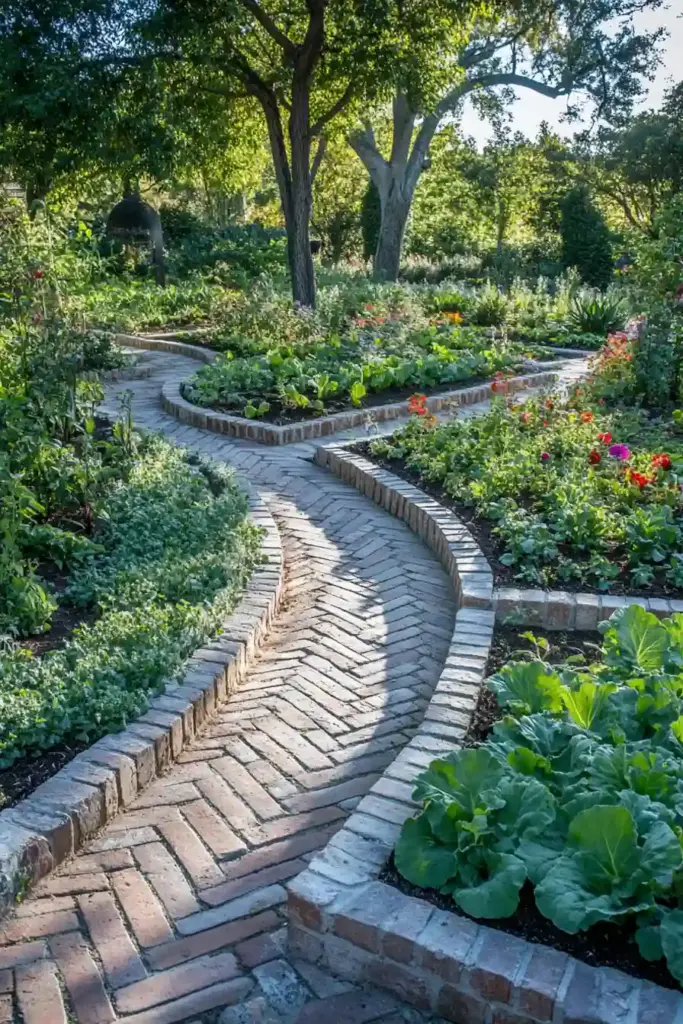
Want your garden to feel like a destination as much as a productive space? Patterned layouts with thoughtfully chosen paving materials can elevate your vegetable garden into an artistic and organized retreat. Think classic herringbone brick paths, symmetrical stone borders, or even whimsical stepping-stone trails winding through the beds.
🌿 Why Use Patterns and Paving?
- Visual clarity: Defined paths make it easier to navigate and manage your space.
- Aesthetic appeal: Adds character and structure to your garden.
- Functional: Paving reduces mud, prevents weed encroachment, and supports wheelbarrow or hose access.
🔨 Ideas to Try:
- Create a checkerboard design with alternating garden beds and stepping stones.
- Use gravel, mulch, or decomposed granite for natural, low-maintenance pathways.
- Frame planting beds with bricks or stone to enhance durability and symmetry.
Patterned and paved garden designs are ideal for gardeners who want their space to look as good as it performs—offering a clean, crisp design that’s as satisfying to walk through as it is to harvest from.
8. Square, Circular, and Artistic Garden Shapes: Design with Personality
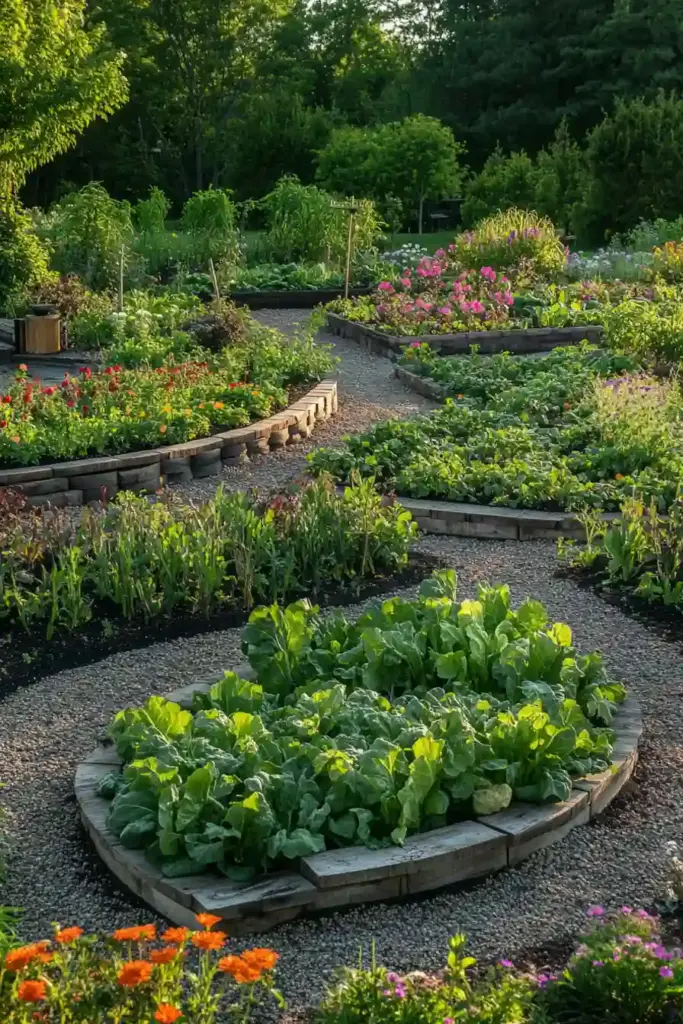
Your vegetable garden doesn’t have to be all straight lines and right angles. Exploring different shapes—like squares, circles, or custom artistic layouts—adds a fun, creative twist to your growing space. These designs don’t just look beautiful—they also improve access, optimize sunlight, and reflect your unique gardening style.
🌿 Shape Up Your Garden:
- Square beds are great for modular planning and grid-based planting (like the popular Square Foot Gardening method).
- Circular layouts create a sense of flow and are easy to work around from all sides.
- Freeform artistic designs can follow the natural contours of your space, perfect for creating a more organic or whimsical garden.
🎨 Design Tips:
- Use curved edges or circular raised beds around a central feature for symmetry and charm.
- Mix bed shapes for visual interest—combine rectangular with triangular or semi-circular beds.
- Artistic layouts often work best with flexible materials like stone, metal edging, or even woven willow borders.
These creative garden shapes are ideal for those who want to turn their vegetable garden into an expression of art, making it a space to enjoy visually as much as practically.
9. Geometric and L-Shaped Garden Layouts: Structure Meets Flexibility
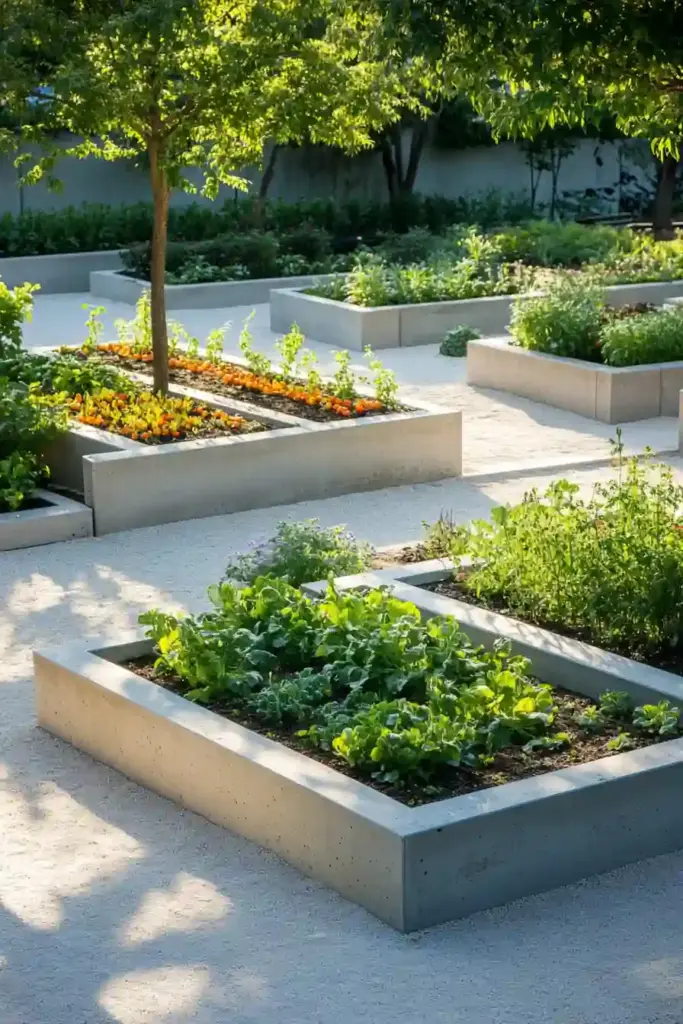
If you like clean lines with a dash of creativity, geometric and L-shaped garden layouts strike the perfect balance. These designs are highly functional, offering clear planting zones while adapting well to a variety of yard shapes—especially corners or awkward spaces.
🔷 Why Geometric Layouts Work:
- Easy planning: Square and rectangular beds are simple to design and organize.
- Great for small spaces: L-shaped beds tuck neatly into corners, maximizing your growing area.
- Modular growth: You can easily expand over time by adding more geometric beds.
🧱 Design Suggestions:
- Use square beds for crops with similar growth habits and water needs.
- Try L-shaped raised beds to define a corner or border a patio or fence.
- Combine different geometric forms—like rectangles and triangles—for a bold, modern layout.
This layout style is especially appealing for gardeners who want structure, adaptability, and a little modern flair in their edible landscape.
10. Radial Garden Bed Layouts: Beauty in Every Direction
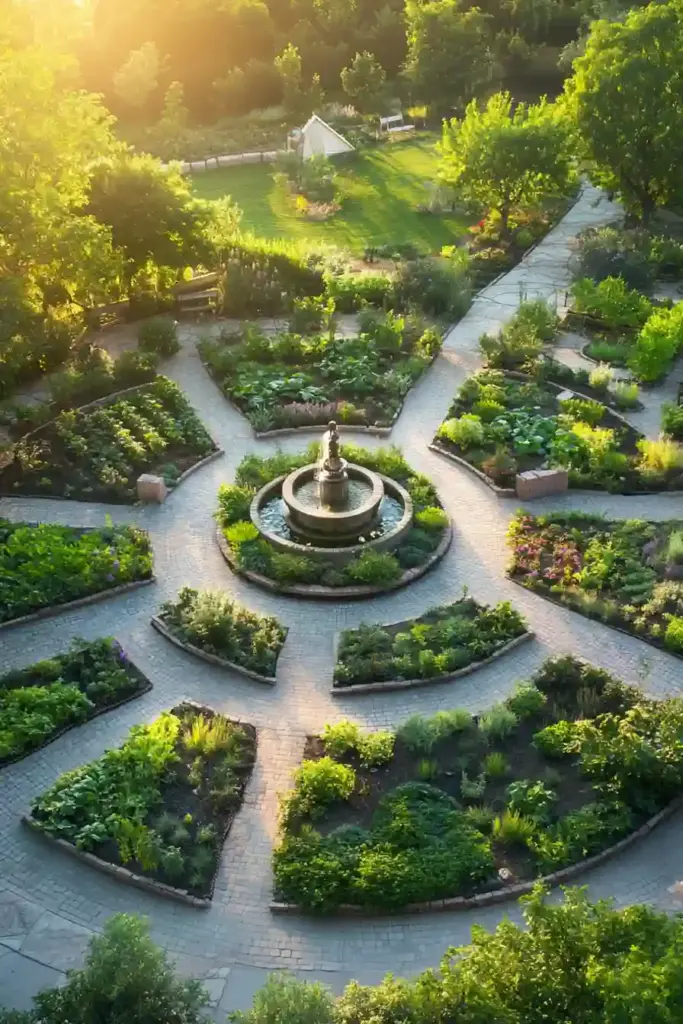
Looking for a show-stopping design that’s as functional as it is beautiful? Radial garden layouts organize planting beds in a circular pattern radiating out from a central point—like the spokes of a wheel. This layout offers maximum sunlight exposure, easy access to each bed, and an unmistakable “wow” factor.
🌞 Why Choose a Radial Layout?
- Central accessibility: Easily reach every bed from the middle without stepping into the soil.
- Maximized sun exposure: Plants receive light evenly as they follow the curve of the sun.
- Aesthetic appeal: Instantly elevates the visual charm of your vegetable garden.
🌿 Design Inspiration:
- Use a focal point like a birdbath, sculpture, or trellis in the center.
- Create paths between beds with gravel, mulch, or stepping stones.
- Combine form with function by integrating herbs and edible flowers along the edges.
Radial gardens are perfect for round or square spaces and for gardeners who love symmetry with a touch of the unexpected.
11. Diagonal Garden Layouts: A Smart Fit for Corners and Unique Spaces
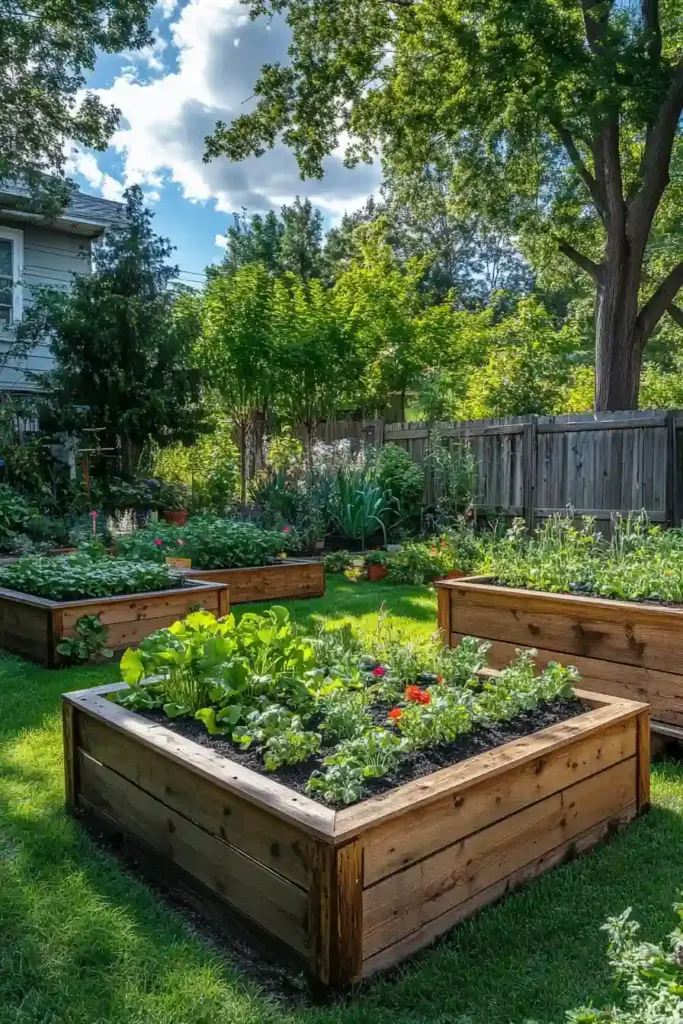
Diagonal garden layouts are an excellent option when you’re working with angular, triangular, or tight spaces—like a backyard corner or along a fence line. By positioning beds at a 45-degree angle, you can turn an awkward space into a productive and visually dynamic garden.
📐 Why Go Diagonal?
- Efficient use of tricky areas: Perfect for corners, wedges, or odd-shaped yards.
- Unique visual perspective: Adds movement and depth to flat or narrow spaces.
- Natural water flow: Diagonal alignment can help with drainage in sloped areas.
🌿 Design Tips:
- Use diagonal raised beds to guide the eye across your space.
- Place taller crops toward the back corner, and trail shorter plants diagonally forward.
- Mix materials—like wood beds with gravel paths—to emphasize the angled layout.
This garden design turns overlooked corners into edible highlights, giving your landscape a modern edge without sacrificing function.
12. Irregular-Shaped Plot Designs: Embrace the Natural Flow
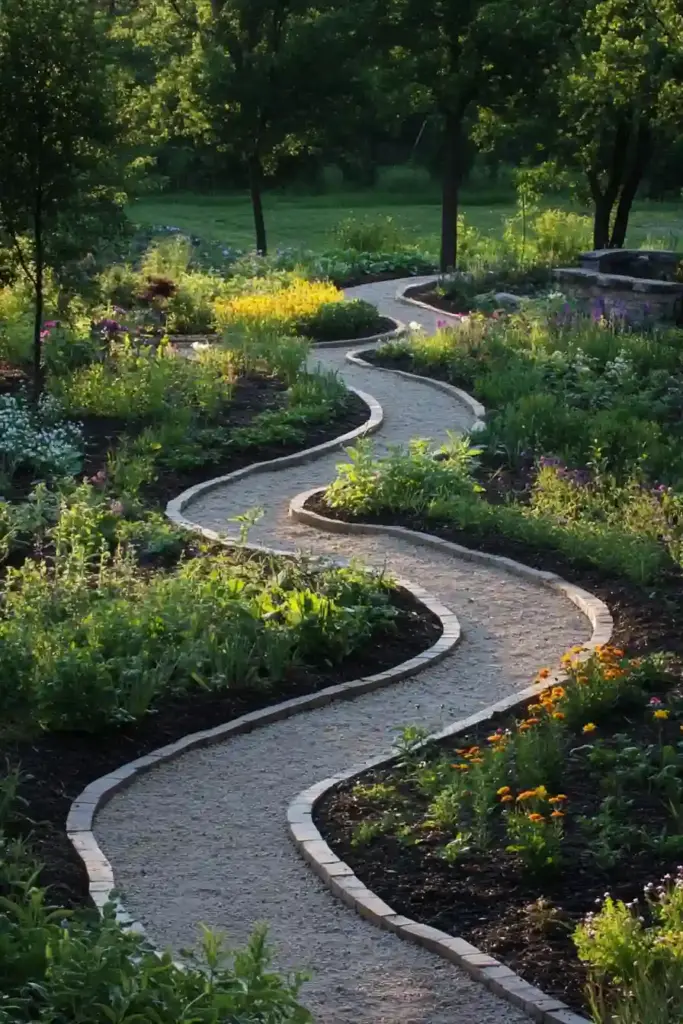
Not every yard is a perfect rectangle—and that’s okay! Irregular-shaped garden plots let you work with what you have, adapting your design to fit curves, slopes, or pie-shaped corners. These layouts are especially well-suited for cottage-style gardens or informal edible landscapes where creativity thrives.
🌿 Why Go Irregular?
- Adaptable: Ideal for sloped yards, curved borders, or unconventional lot shapes.
- Naturalistic feel: Mimics the flow of nature and creates a relaxed, organic vibe.
- Personalized: Each bed can be uniquely shaped and sized to fit your space and style.
🌼 Design Suggestions:
- Use winding paths and asymmetrical beds to create a meandering garden journey.
- Soften edges with low herbs, groundcovers, or mulch borders.
- Incorporate boulders, logs, or native plants to blend seamlessly into the environment.
Irregular garden designs invite you to ditch the ruler and design intuitively—perfect for gardeners who want a space that feels wild, welcoming, and uniquely theirs.
13. Mandala Edible Garden Designs: A Garden with Meaning and Magic
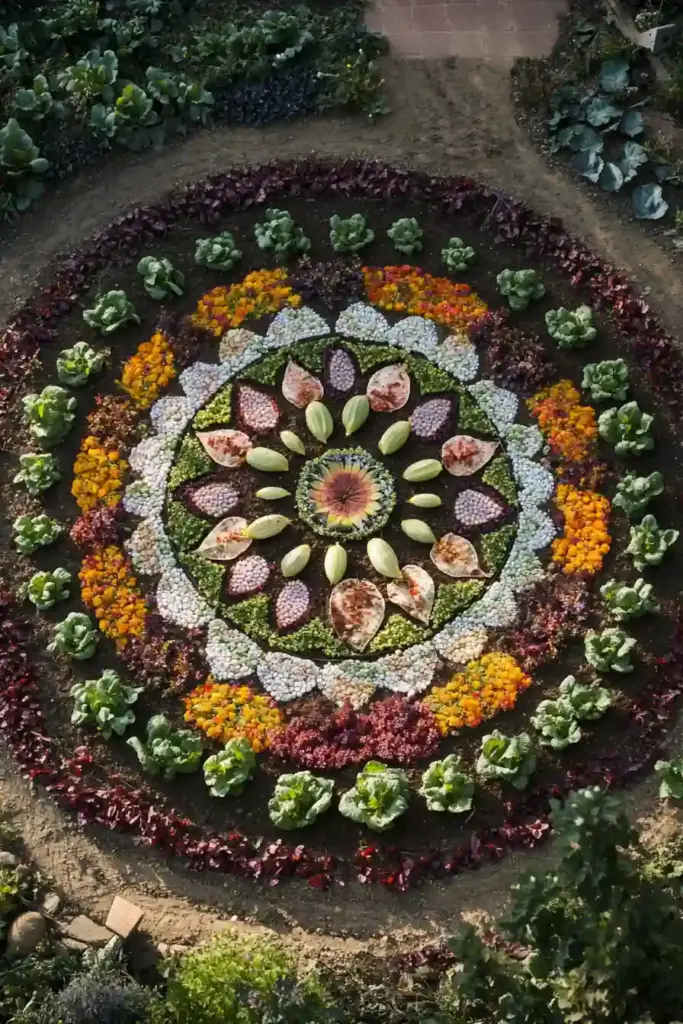
Inspired by ancient symbols of harmony and balance, mandala garden designs bring a spiritual and artistic dimension to growing food. These layouts feature circular or radial patterns with repeating geometric shapes, creating a sacred space that feels both peaceful and productive.
🌿 Why Choose a Mandala Garden?
- Symbolic beauty: Incorporates shapes and symmetry that reflect nature’s balance.
- Functional layout: Beds are arranged for easy access, often around a central focal point.
- Mindful gardening: The meditative design invites calm, intentional interaction with your plants.
✨ How to Design One:
- Start with a circular layout divided into equal “slices” or segments like a pie chart.
- Use pathways (gravel, mulch, or stone) to separate planting zones.
- Place a bench, sculpture, or small fountain at the center to anchor the space.
- Plant in repeating patterns using colorful herbs, leafy greens, and edible flowers for both beauty and biodiversity.
Mandala gardens are perfect for those who want their vegetable garden to be more than just functional—it becomes a healing space, a sanctuary, and a living piece of art.
Essential Design Elements to Enhance Your Vegetable Garden
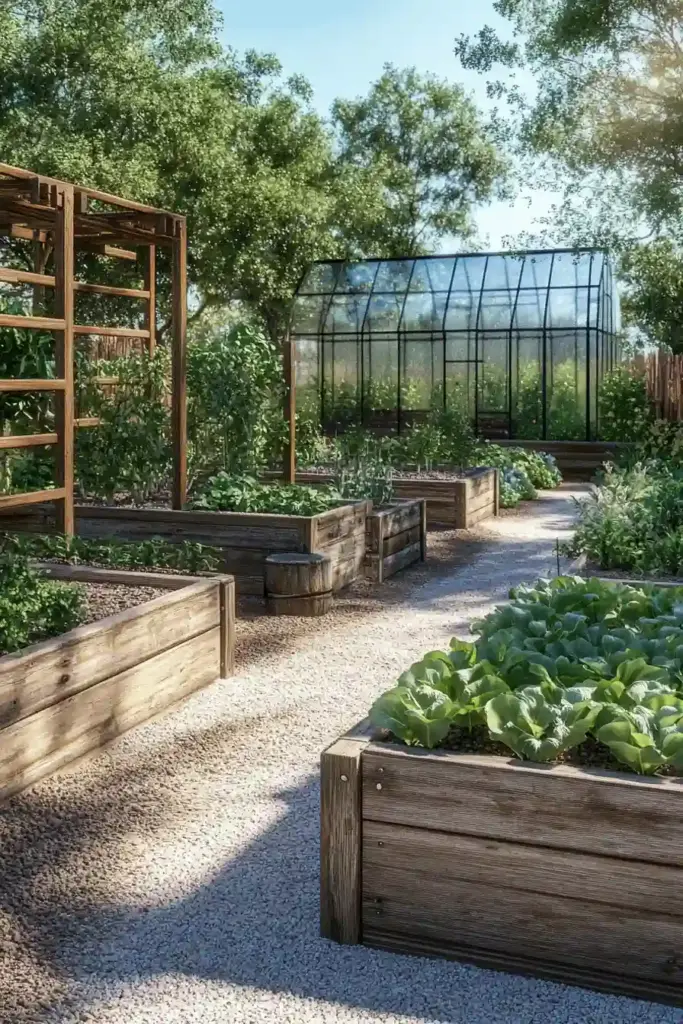
A stunning garden layout is only as good as its foundational elements. These practical features not only boost your garden’s productivity but also add style, comfort, and functionality. Let’s explore how to build your garden from the ground up—with raised beds, paths, fencing, and more.
1. Raised Beds: Structure and Soil Control
Raised beds are the backbone of many garden layouts. They help contain your soil, improve drainage, and make planting and harvesting easier on your back.
- Materials: Use rot-resistant wood (like cedar), galvanized metal, or recycled composite boards.
- Depth: Aim for at least 6–12 inches for most vegetables.
- Tips: Line beds with landscape fabric to prevent weeds, and secure with galvanized screws to avoid rust.
2. Pathways: Keep It Clean and Accessible
Well-planned paths make it easy to move through your garden without compacting soil.
- Grass paths: Soft underfoot and natural-looking, but require mowing.
- Mulch paths: Inexpensive and great for water retention—just top them off yearly.
- Gravel or brick paths: Durable and stylish, perfect for formal layouts or high-traffic areas.
👉 Pro Tip: Define paths with edging stones or recycled bricks to prevent soil runoff and keep weeds at bay.
3. Fences and Gates: Define and Protect
A beautiful fence gives your garden structure while keeping critters out and adding vertical growing opportunities.
- Design options: Classic picket, modern metal panels, or rustic wood slats.
- Add function: Train climbing veggies like peas or squash along the fence.
- Gates: Choose a charming gate design to frame your entrance—archways work great with flowering vines!
4. Greenhouses: Extend Your Growing Season
Adding a greenhouse—whether a small cold frame or full-size structure—can transform your garden into a year-round food source.
- Cold frames: Budget-friendly and ideal for seed starting.
- Hoop houses: Great for DIYers wanting extra warmth on a larger scale.
- Traditional greenhouses: Durable and elegant, perfect for serious growers or aesthetic appeal.
5. Decorative Features: Style Meets Function
Incorporate small touches that reflect your personality and make your garden feel like an inviting retreat.
- Benches: Create a quiet corner for morning coffee or garden journaling.
- Trellises and obelisks: Add vertical interest and support climbing crops.
- Water features: Birdbaths or small fountains attract pollinators and bring soothing ambiance.
These elements don’t just make your vegetable garden more beautiful—they make it more usable, accessible, and enjoyable day-to-day.
Conclusion: Design a Garden That Feeds Your Body and Soul
Creating a vegetable garden is about more than growing food—it’s about cultivating joy, creativity, and connection with the earth. Whether you’re working with a tiny corner plot or a sprawling backyard, there’s a design out there that fits your space, your needs, and your personal style.
From simple rows to intricate mandala layouts, every garden design offers a unique way to turn your outdoor space into a living, edible oasis. By combining smart layout ideas with thoughtful features like raised beds, beautiful pathways, and charming décor, you’ll not only boost your harvest—but also create a garden you’ll love spending time in.
Happy planting—and may your garden flourish with both beauty and bounty! 🌿✨

